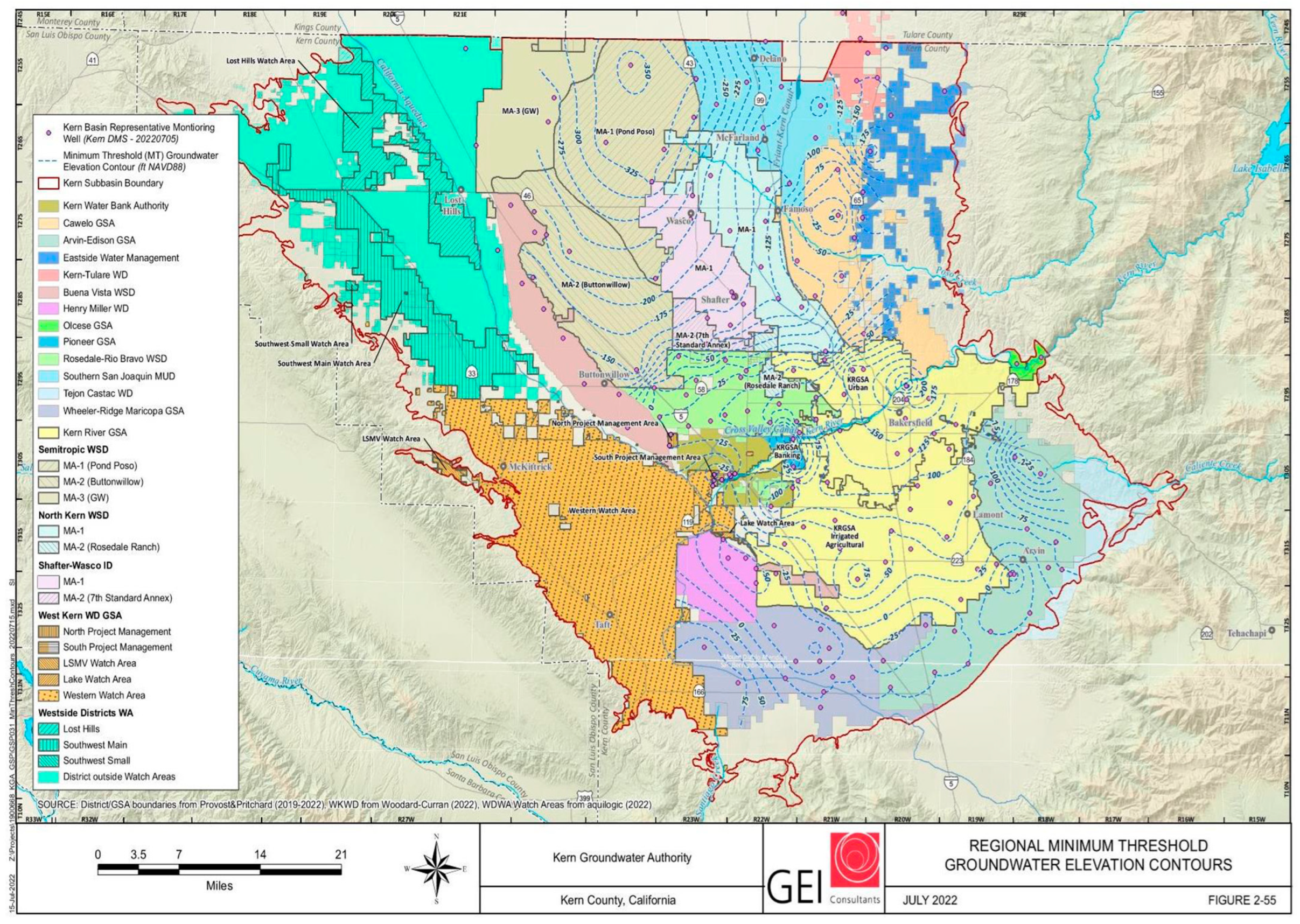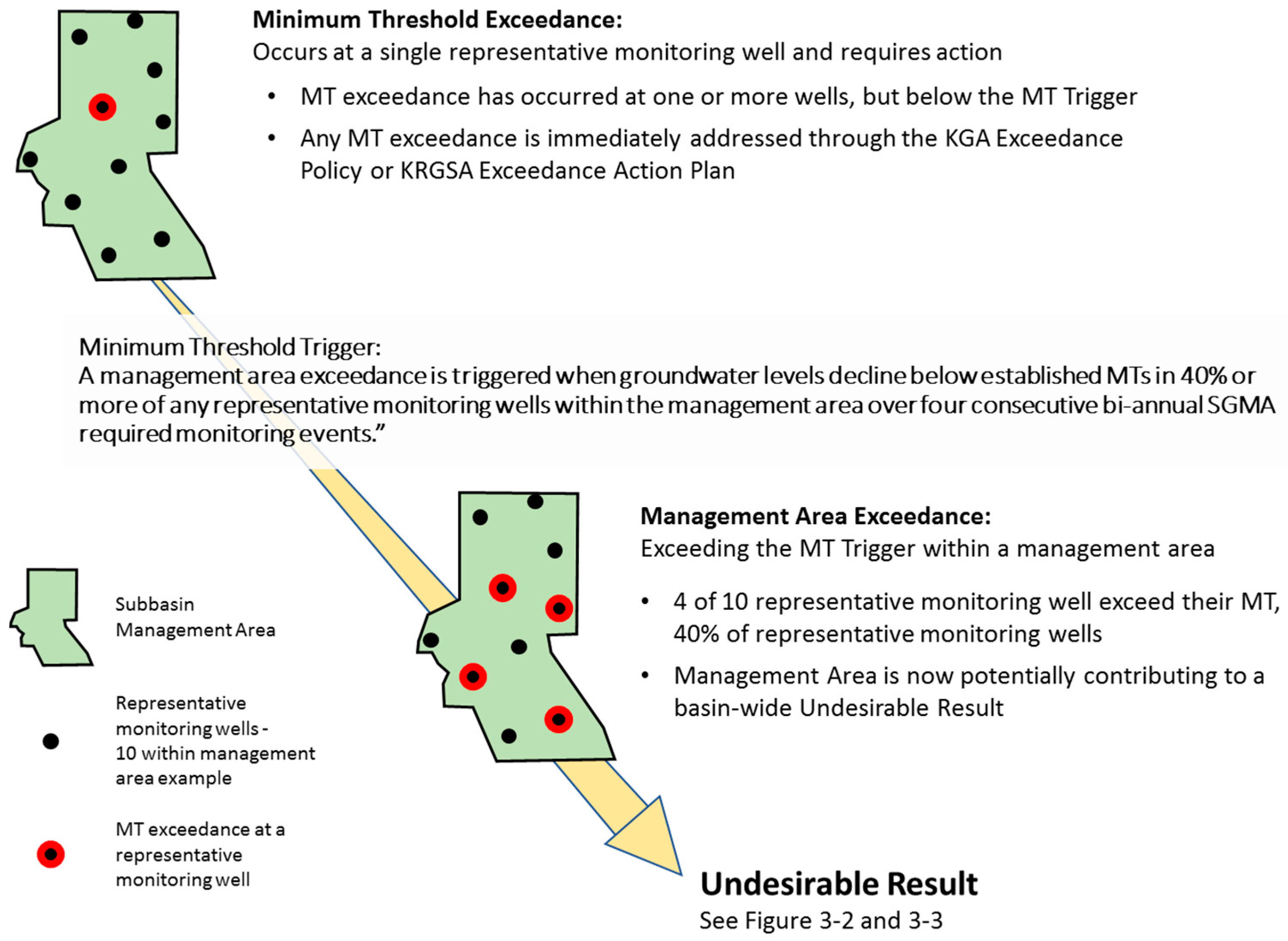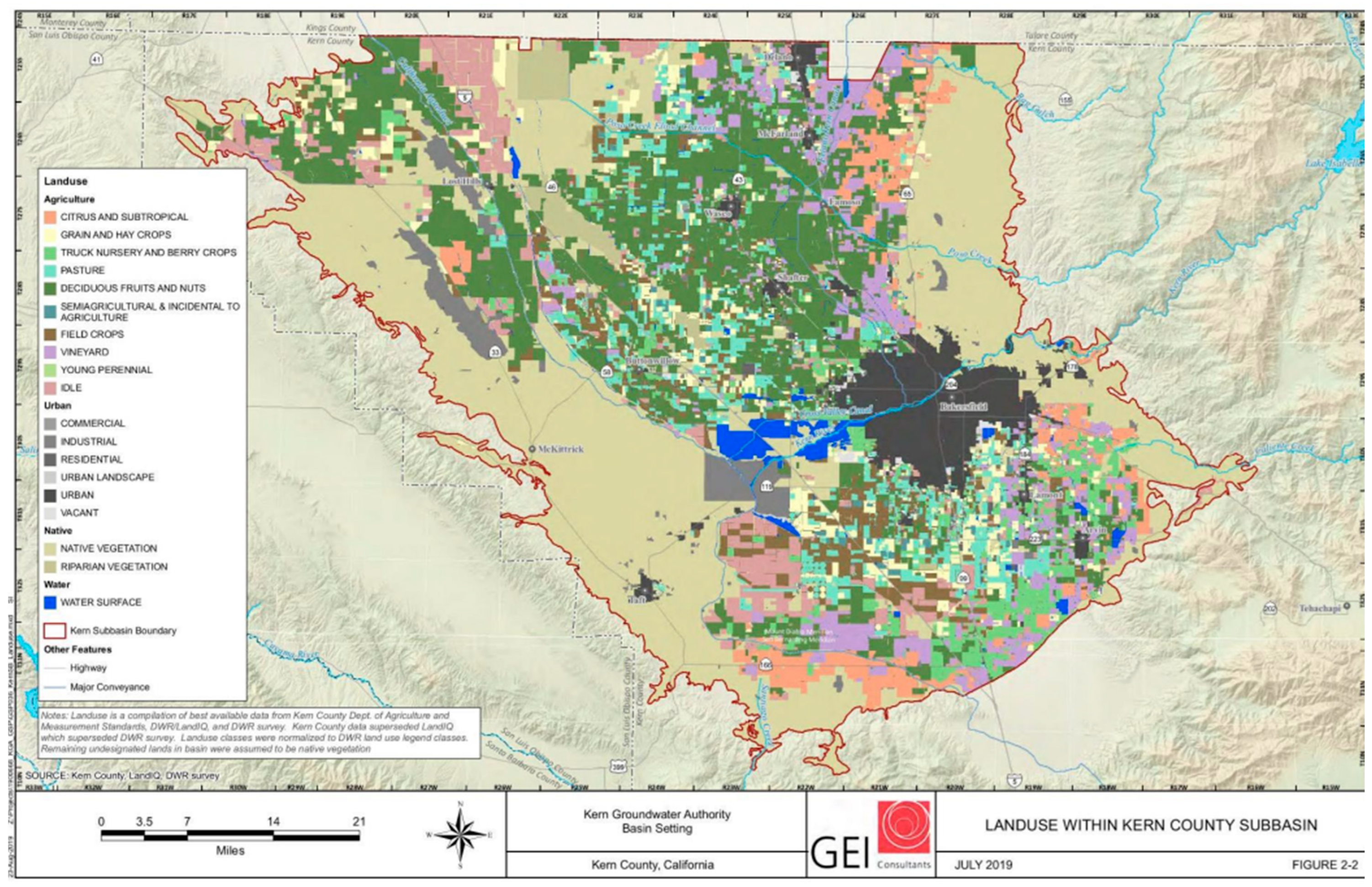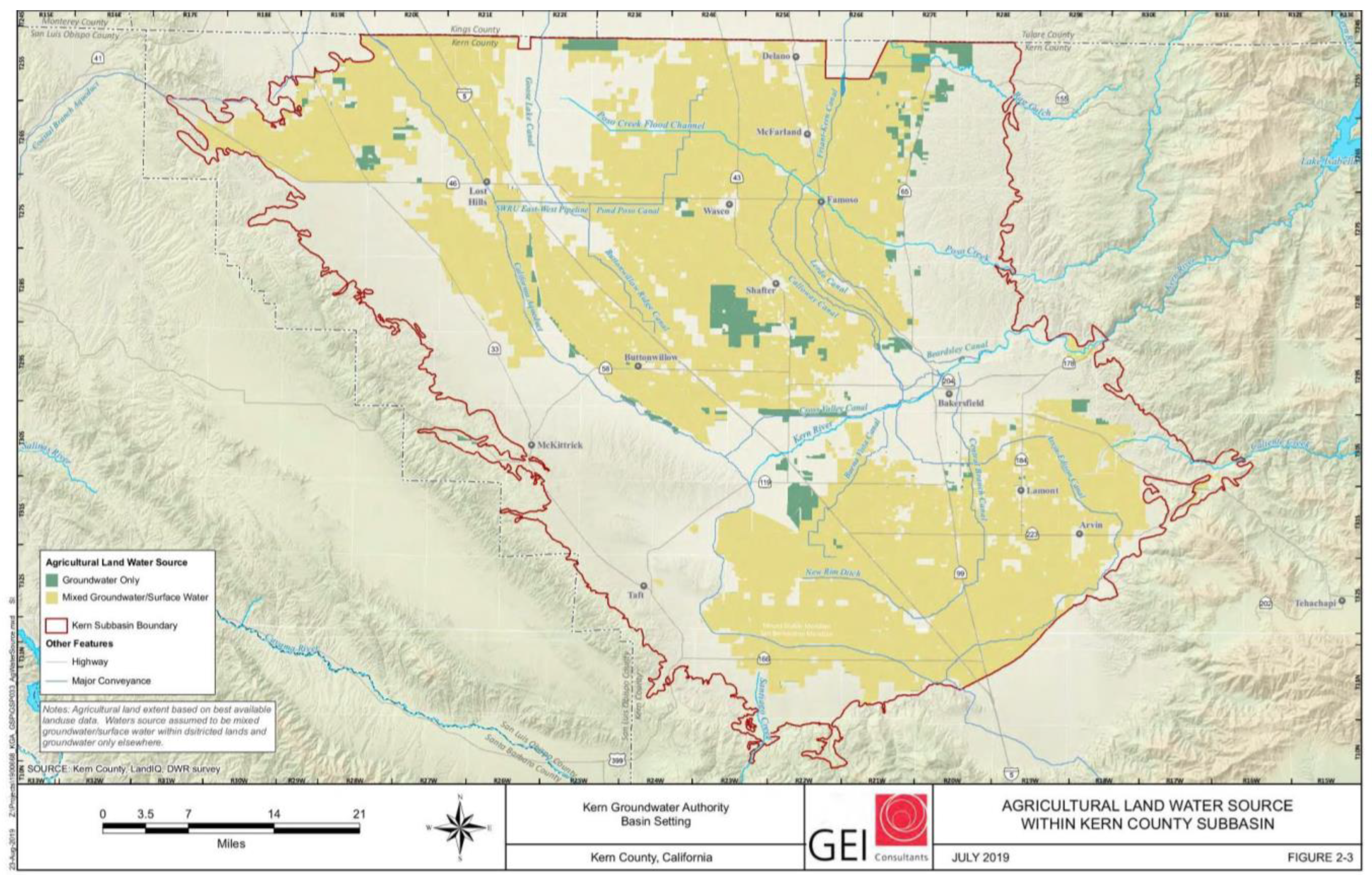Groundwater Sustainability Planning in California: Recommendations for Strengthening the Kern Groundwater Sustainability Plan
Abstract
1. Introduction
SGMA Requirements
2. Kern Groundwater Sustainability Plan Deficiencies and Recommendations
2.1. Inconsistencies across Sub-Basins
2.2. Inadequate Data
2.3. Subsidence Needs a Better Understanding
3. Recommendations
Author Contributions
Funding
Data Availability Statement
Acknowledgments
Conflicts of Interest
References
- Dillon, P.; Fernández Escalante, E.; Megdal, S.B.; Massmann, G. Managed Aquifer Recharge for Water Resilience. Water 2020, 12, 1846. [Google Scholar] [CrossRef]
- Marwaha, N.; Kourakos, G.; Levintal, E.; Dahlke, H.E. Identifying Agricultural Managed Aquifer Recharge Locations to Benefit Drinking Water Supply in Rural Communities. Water Resour. Res. 2021, 57, e2020WR028811. [Google Scholar] [CrossRef]
- Quandt, A.; Larsen, A.E.; Bartel, G.; Okamura, K.; Sousa, D. Sustainable groundwater management and its implications for agricultural land repurposing. Reg. Environ. Chang. 2023, 23, 120. [Google Scholar] [CrossRef]
- Rohde, M.M.; Froend, R.; Howard, J. A global synthesis of managing groundwater dependent ecosystems under sustainable groundwater policy. Groundwater 2017, 55, 293–301. [Google Scholar] [CrossRef] [PubMed]
- Jasechko, S.; Seybold, H.; Perrone, D.; Fan, Y.; Shamsudduha, M.; Taylor, R.G.; Fallatah, O.; Kirchner, J.W. Rapid groundwater decline and some cases of recovery in aquifers globally. Nature 2024, 625, 715–721. [Google Scholar] [CrossRef] [PubMed]
- Greene, C. “Drought isn’t just water, it is living”: Narratives of drought vulnerability in California’s San Joaquin Valley. Geoforum 2021, 121, 33–43. [Google Scholar] [CrossRef]
- Olivier, C. As Kern County Goes, So Goes the Nation; Capitol Weekly: Sacramento, CA, USA, 3 May 2022. [Google Scholar]
- Sugg, Z. An Equity Autopsy: Exploring the Role of Water Rights in Water Allocations and Impacts for the Central Valley Project during the 2012–2016 California Drought. Resources 2018, 7, 12. [Google Scholar] [CrossRef]
- Hanak, E.; Lund, J.; Arnold, B. Water Stress and a Changing San Joaquin Valley; Public Policy Institution of California: San Francisco, CA, USA, 2017. [Google Scholar]
- California Department of Water Resources. California’s Groundwater Conditions: Semi-Annual Update, October 2023, Fall Bulletin 118 Information Update. October 2023. Available online: https://cawaterlibrary.net/document/californias-groundwater-conditions-semi-annual-update-october-2023/ (accessed on 10 February 2023).
- Bostic, D. At Risk: Public Supply Well Vulnerability Under California’s Sustainable Groundwater Management Act; Pacific Institute: Oakland, CA, USA, 2021; Available online: https://pacinst.org/publication/at_risk_wells_sgma/ (accessed on 22 March 2023).
- Gosselin, P. Groundwater Sustainability Plan; Department of Water Resources: Kern County, CA, USA, 2022; Available online: https://kerngwa.com/wp-content/uploads/2022/07/kga-amended-gsp-submitted-july-2022.pdf (accessed on 10 February 2023).
- California Department of Water Resources. Major Milestone to Achieving Sustainable Groundwater Management; California Department of Water Resources: Sacramento, CA, USA, 13 January 2022.
- Eki Environment and Water. Management Area Plan. Arvin-Edison Management Area, Kern County Subbasin. December 2019. Available online: https://kerngwa.com/wp-content/uploads/2022/07/arvin-edison-water-storage-district-management-area-plan.pdf (accessed on 10 February 2023).
- Mknelly, B. The Sustainable Groundwater Management Act (SGMA): Long Overdue, But Is It Living Up to Its Potential? Bachelor’s Thesis, Scripps College, Claremont, CA, USA, 2021. Available online: https://scholarship.claremont.edu/scripps_theses/1697 (accessed on 10 February 2023).
- Water Rights in California; Water Education Foundation: Sacramento, CA, USA, 22 June 2020; Available online: https://www.watereducation.org/aquapedia/water-rights-california (accessed on 10 February 2023).
- Kern County Subbasin Groundwater Sustainability Agencies. Kern County Subbasin Basin No. 5-022.14. Groundwater Sustainability Plans: (GSPs) Third Annual Report Water Year 2021. Todd Groundwater. 2022. Available online: https://kerngwa.com/wp-content/uploads/2022/07/2022-annual-report-final-3-30-2022.pdf (accessed on 10 February 2023).
- Todd Groundwater. Cawelo GSA REVISED Groundwater Sustainability Plan. 14 July 2022. Available online: https://kerngwa.com/wp-content/uploads/2022/07/revised-final-cawelo_gsp_jul14_2022-complete-clean.pdf (accessed on 10 February 2023).
- Maven. Groundwater Rights Primer: What Agencies & Project Developers Need To Know. MAVEN’S NOTEBOOK|Water News. 7 March 2018. Available online: https://mavensnotebook.com/2018/03/07/groundwater-rights-primer-agencies-project-developers-need-know/ (accessed on 10 February 2023).
- Kelsey, R.; Hart, A.; Butterfield, H.S.; Dink, V. Groundwater sustainability in the San Joaquin Valley: Multiple benefits if agricultural lands are retired and restored strategically. Calif. Agric. 2018, 72, 150–154. [Google Scholar] [CrossRef]
- Wartenberg, A.C.; Moanga, D.; Potts, M.D.; Butsic, V. Limited Economic-Ecological Trade-Offs in a Shifting Agricultural Landscape: A Case Study From Kern County, California. Front. Sustain. Food Syst. 2021, 5, 650727. [Google Scholar] [CrossRef]
- California State Water Resources Control Board. Human Right to Water Portal. Available online: https://www.waterboards.ca.gov/water_issues/programs/hr2w/ (accessed on 10 February 2023).
- Feinstein, L.; Phurisamban, R.; Ford, A.; Tyler, C.; Crawford, A. Drought and Equity in California; Pacific Institute: Oakland, CA, USA, 2017. [Google Scholar]
- Faunt, C.C.; Sneed, M.; Traum, J.; Brandt, J.T. Water availability and land subsidence in the Central Valley, California, USA. Hydrogeol. J. 2016, 24, 675–684. [Google Scholar] [CrossRef]
- Todd Groundwater. Kern County Subbasin Groundwater Sustainability Plans. 31 March 2023. Available online: https://kerngwa.com/wp-content/uploads/2023/04/Kern-BASIN-5-022.14-WY2022-AnnReport-03-31-2023.pdf (accessed on 10 February 2023).




| Number of Wells | Number of Dewatered Wells | |||||||
|---|---|---|---|---|---|---|---|---|
| M | D | A | % M/D Wells | M | D | A | % M/D Wells | |
| CWD | 0 | 93 | 197 | 32% | 0 | 0 | 0 | 0% |
| EWMA | 2 | 11 | 41 | 24% | 0 | 0 | 0 | 0% |
| NK | 1 | 22 | 161 | 13% | 0 | 0 | 2 | 0% |
| KTWD | 0 | 18 | 94 | 16% | 0 | 0 | 0 | 0% |
| RRB | 24 | 149 | 156 | 53% | 0 | 0 | 0 | 0% |
| SWID | 16 | 68 | 118 | 42% | 0 | 8 | 7 | 10% |
| SSJMUD | 19 | 67 | 243 | 26% | 0 | 13 | 11 | 15% |
| SWSD | 4 | 138 | 763 | 16% | 0 | 10 | 4 | 7% |
| WDWA | 0 | 2 | 35 | 5% | 0 | 0 | 0 | 0% |
| WKWD | 13 | 0 | 0 | 100% | 0 | 0 | 0 | 0% |
| 7th Standard | 2 | 9 | 19 | 37% | 0 | 2 | 0 | 18% |
| Total | 81 | 577 | 1827 | 26% | 0 | 33 | 24 | 5% |
| Number of Wells | Number of Dewatered Wells | |||||||
|---|---|---|---|---|---|---|---|---|
| M | D | A | % M/D Wells | M | D | A | % M/D Wells | |
| CWD | 0 | 93 | 197 | 32% | 0 | 3 | 1 | 3% |
| EWMA | 2 | 11 | 41 | 24% | 0 | 3 | 0 | 23% |
| NK | 1 | 22 | 161 | 13% | 0 | 2 | 5 | 9% |
| KTWD | 0 | 18 | 94 | 16% | 0 | 0 | 0 | 0% |
| RRB | 24 | 149 | 156 | 53% | 0 | 21 | 0 | 12% |
| SWID | 16 | 68 | 118 | 42% | 0 | 22 | 13 | 26% |
| SSJMUD | 19 | 67 | 243 | 26% | 0 | 29 | 25 | 34% |
| SWSD | 4 | 138 | 763 | 16% | 0 | 41 | 52 | 29% |
| WDWA | 0 | 2 | 35 | 5% | 0 | 0 | 0 | 0% |
| WKWD | 13 | 0 | 0 | 100% | 0 | 0 | 0 | 0% |
| 7th Standard | 2 | 9 | 19 | 37% | 0 | 5 | 2 | 45% |
| Total | 81 | 577 | 1827 | 26% | 0 | 126 | 98 | 19% |
Disclaimer/Publisher’s Note: The statements, opinions and data contained in all publications are solely those of the individual author(s) and contributor(s) and not of MDPI and/or the editor(s). MDPI and/or the editor(s) disclaim responsibility for any injury to people or property resulting from any ideas, methods, instructions or products referred to in the content. |
© 2024 by the authors. Licensee MDPI, Basel, Switzerland. This article is an open access article distributed under the terms and conditions of the Creative Commons Attribution (CC BY) license (https://creativecommons.org/licenses/by/4.0/).
Share and Cite
Okamura, K.; Quandt, A. Groundwater Sustainability Planning in California: Recommendations for Strengthening the Kern Groundwater Sustainability Plan. Water 2024, 16, 2442. https://doi.org/10.3390/w16172442
Okamura K, Quandt A. Groundwater Sustainability Planning in California: Recommendations for Strengthening the Kern Groundwater Sustainability Plan. Water. 2024; 16(17):2442. https://doi.org/10.3390/w16172442
Chicago/Turabian StyleOkamura, Kiana, and Amy Quandt. 2024. "Groundwater Sustainability Planning in California: Recommendations for Strengthening the Kern Groundwater Sustainability Plan" Water 16, no. 17: 2442. https://doi.org/10.3390/w16172442
APA StyleOkamura, K., & Quandt, A. (2024). Groundwater Sustainability Planning in California: Recommendations for Strengthening the Kern Groundwater Sustainability Plan. Water, 16(17), 2442. https://doi.org/10.3390/w16172442








